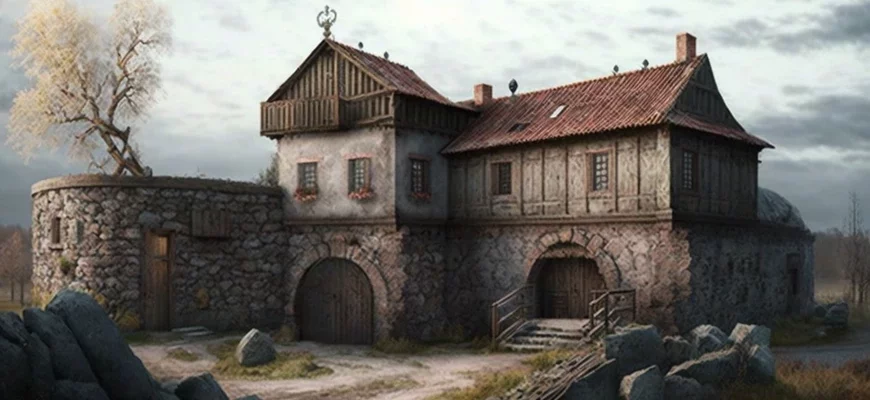Kyivan Rus was a period when the first stone structures appeared on the territory of modern Ukraine. This was an important step in the development of architecture and infrastructure. Stone structures began to be built in Kyivan Rus in the 11th century. At that time, this was a very important step, as wooden buildings were often destroyed by fires. Stone fortresses were important elements of defense in Kievan Rus. They protected cities and villages from enemy attacks. The construction of stone fortresses was a very complex and costly process. Stone fortresses consisted of stone walls that were up to several meters thick and towers that were used for observation and shooting with bows and crossbows. Stone structures were important for Kievan Rus because they helped to maintain defensive lines and protect cities from enemy attacks.
- Historical context of stone structures
- Stone fortresses
- Construction and architecture of fortresses
- Stone churches
- Construction and architecture of churches
- Stone palaces and other buildings
- Description and architecture of palaces and other stone structures
- The role of stone structures in Kievan Rus
- The defensive role of stone fortresses
- The religious and cultural role of stone churches
- The political and social role of stone palaces and other buildings
- The importance of stone structures for studying the history of Kievan Rus
- Conclusion
Historical context of stone structures
Stone structures in Kievan Rus’ were important in terms of the development of architecture and infrastructure in the territory of modern Ukraine. The period from the 11th to the 13th centuries is considered the golden age of Kievan Rus’. During this time, culture, architecture, trade, and diplomacy flourished in Rus. The growth of power and wealth of princes and boyars was reflected in new buildings and structures that were erected in cities and fortresses. Stone fortresses and palace complexes became symbols of the heyday of Kievan Rus.
In addition, the construction of stone structures was linked to historical events that took place in Rus. For example, after the Mongol invasion in the 13th century, stone fortresses became even more important elements of defense against foreign enemies. The construction of stone fortresses became a national issue for Rus, as it was necessary to preserve the independence and security of the country.
Thus, the historical context of stone structures in Kievan Rus was linked to the development of culture, power, and economy in the period from the 11th to the 13th centuries, as well as to the need to defend the country after the Mongol invasion in the 13th century.
Stone fortresses
Stone fortresses in Kievan Rus were important defensive structures and symbols of the power and might of the ancient Russian principalities. They played a significant role in protecting the territory from enemy attacks and defending the borders of the principalities.
One of the most famous stone fortresses in Kievan Rus is the fortress in Kamianets-Podilskyi, which was founded in the 10th century and remains in excellent condition to this day. Another well-known example of a stone fortress is the Tustan Fortress, which was founded in the 11th century and is located in the territory of the modern Lviv region.
Other stone fortresses in Kievan Rus’ are also worth mentioning, such as the fortress in Belogorodka (modern-day Belogorsk Fortress in Russia), the fortress in Chernihiv, the fortress in Kropyvnytskyi (Kirovohrad), the fortress in Ostroh (modern-day village of Oster in the Kyiv region), and others.
All these fortresses have their own unique history and architecture, which testify to their importance in the history of Kievan Rus.
Construction and architecture of fortresses
The construction and architecture of fortresses in Kievan Rus were determined by geographical and natural conditions, the availability of building materials, and strategic needs. Stone fortresses were built on hills, near rivers and lakes, and at important intersections of trade routes.
The fortresses consisted of a large stone wall with towers and turrets surrounding an inner courtyard, which included buildings such as the prince’s palace, a chapel, shops, warehouses, and other structures. The fortresses also had wells that provided water for the inhabitants and defenders.
The main building material for fortresses was stone, which was found locally. Fortresses usually had one or more entrances, which were secured by gates or wickets. The gates and wickets of fortresses were well guarded and ensured the safety of the inhabitants.
The architecture of fortresses varied depending on the period of their construction and the region. In the early Middle Ages, fortresses were simpler in design and construction. However, over time, fortresses became more complex and had more elements of decoration and ornamentation.
Thus, the construction and architecture of fortresses in Kievan Rus’ were important components of military defense and symbols of the power and authority of the ancient Russian principalities. They played an important role in protecting transport routes and trade, which were key elements of the economy of Kievan Rus’. Fortresses were also places where precious relics, documents, and other valuables were stored, making them cultural and historical sites.
Among the most famous fortresses of Kievan Rus are the Kiev Fortress, the Chernihiv Fortress, the Galician Fortress, the Lyubets Fortress, Sudova Vyshnia, and many others. Some of these fortresses have survived to this day and are popular tourist attractions in Ukraine.
Traditional techniques and methods were used in the construction of the fortresses of Kievan Rus, such as broken stone walls, which were resistant to impact, and amber foundations, which were considered very strong and durable. Wooden elements such as towers and turrets were also used to complement the stone walls.
All these elements created an impressive architectural style that added to the historical significance of the fortresses of Kievan Rus. Ancient fortresses were not only symbols of power and authority, but also testified to the high level of technological and cultural development in Kievan Rus.
Stone churches
Stone churches in Kievan Rus are remarkable monuments of architecture and culture that have survived to this day. The construction of stone churches in Kievan Rus was associated with the development of the Orthodox religion and the change in the beliefs of the population from paganism to Christianity. Stone churches were created to preserve holy relics and provide a safe place for religious ceremonies.
One of the most famous stone churches of Kievan Rus is St. Sophia Cathedral, located in the center of Kyiv. This cathedral was built in the 11th century and is considered a landmark of Kievan Rus. It has five domes decorated with frescoes, mosaics, and icons, as well as an impressive mosaic on its main facade.
Another famous stone church is the Holy Trinity Church in Pereyaslav, located in the city of Pereyaslav-Khmelnytskyi. This church was built in the 12th century and is one of the oldest stone churches in Ukraine. It has five main towers and two side apses, as well as decorative reliefs and paintings on its walls.
Other famous stone churches in Kievan Rus include the Pechersk Lavra, the Transfiguration Cathedral in Chernihiv, St. George’s Cathedral in Chernihiv, and many others. These churches are monuments of world culture and art that have survived to this day and are popular tourist attractions.
The Pechersk Lavra was particularly important in the development of stone architecture in Kievan Rus. It was a large religious center that included many temples, monasteries, and other buildings. Under the influence of this monastic community, new architectural forms and technologies appeared in Kievan Rus, which were used in the construction of stone churches.
For example, new stonework techniques appeared, which made buildings more durable and resistant to wear and tear. New construction technologies were invented, which allowed for complex structures and architectural forms.
Masters who knew how to work with stone and create complex architectural forms also played a significant role in the development of stone architecture in Kievan Rus. Many of these masters came from the east, in particular from Georgia and Armenia, where highly skilled stone architecture was developing.
All these factors influenced the development of stone architecture in Kievan Rus and made it one of the most outstanding forms of architecture of that time. Many monuments of stone architecture have survived to this day, testifying to the high level of development of this art form during that period.
Construction and architecture of churches
The construction of churches in Kievan Rus was associated with the Christianization of the population and the development of the Orthodox Church. The first churches were built of wood, but later, with the development of stone architecture, stone temples were built.
The most famous stone churches of Kievan Rus are St. Sophia Cathedral in Kyiv and the Transfiguration Cathedral in Chernihiv. St. Sophia Cathedral was built in the 11th century and is considered one of the most outstanding monuments of stone architecture not only in Kievan Rus, but in all of Europe. The Transfiguration Cathedral was built at the beginning of the 12th century and is of great cultural and historical value.
A characteristic feature of the stone churches of Kievan Rus is their rich decor. The facades of the churches were decorated with stone carvings, bas-reliefs, mosaics, and frescoes. Such decor shows the high level of art of that time and testifies to the influence of Greek and Roman cultures on the culture of Kievan Rus.
The stone churches of Kievan Rus also used complex structures and architectural forms that allowed for the creation of spectacular architectural compositions. For example, the St. Sophia Cathedral in Kyiv had golden domes with several rows of ribs, which gave them the appearance of flowers or crowns.
Considerable attention was also paid to the interior decoration of stone churches in Kievan Rus. Inside the church, icons on a gold base were installed, as well as mosaics and frescoes with Byzantine and Russian motifs.
Overall, the architecture of stone churches in Kievan Rus reflects the richness and beauty of the culture of that time, as well as its connection with other cultures, in particular Greek and Roman. In addition, stone churches were not only religious buildings, but also served as symbols of power and society, emphasizing the role of the church in the lives of the people of that time.
Stone palaces and other buildings
In addition to church buildings, stone palaces and other interesting architectural structures were also built in Kievan Rus.
One of the most famous stone palaces in Kievan Rus’ is the palace of Prince Vladimir Monomakh in Chernihiv, which was built in the 12th century. This palace is characterized by a unique style, which shows the influence of Byzantine architecture. It features complex architectural forms and paintings, making it one of the most impressive monuments of Kievan Rus.
Another notable structure of Kievan Rus is the stone commercial palace known as the Derevlyansky Palace. It was built in the 12th century and has survived to this day. The palace is characterized by unusual architecture, including complex balconies and various decorations. The palace also has several stone halls where various events were once held.
In addition to palaces, other stone structures such as bridges, fortresses, and towers were also built in Kievan Rus. For example, the White Tower in Chernihiv is the tallest stone tower in Kievan Rus, built in the 12th century. This tower, over 45 meters high, was used for observation and signaling.
All these stone structures demonstrate the high level of technical and architectural knowledge and skills in Kievan Rus. They were built using stone, which ensured the strength and durability of the structures and also allowed for the use of complex processing and decoration techniques.
The techniques used in the construction of these structures included stone processing techniques such as turning, grinding, and carving. The use of such techniques made it possible to achieve high quality and detail in the decorative finishing of the structures.
Description and architecture of palaces and other stone structures
In Kievan Rus, palaces and other stone structures were built to demonstrate the power and wealth of the rulers. One of the most famous palaces is the Palace of Prince Yaroslav the Wise, built in the 11th century in Kiev. It was built in the Byzantine style, using white stone. The palace consisted of two floors and had several rooms decorated with mosaics and carvings.
Another important palace in Kyiv was the Palace of Vladimir Monomakh, built in the 12th century. It had a huge hall for receiving guests, decorated with mosaics and frescoes. The palace also had several rooms decorated with carvings.
Among other buildings, the Kyiv-Pechersk Lavra stands out, with its many palaces and other buildings. In the lavra, you can see the House of Bishop Peter, built in the 18th century in the Baroque style. It had two floors decorated with frescoes and murals.
Churches, monasteries, and other religious buildings were also built in Kievan Rus, such as St. Sophia Cathedral, the Church of the Tithes, the Pechersk Lavra, and others. These buildings were of great cultural and historical significance for Kievan Rus.
In addition, elements such as domes, arches, columns, rosettes, carvings, and other decorative elements were used in the stone architecture of Kievan Rus. Many buildings featured mosaics and frescoes that were painted and decorated with gold and silver. This allowed for the creation of masterful works of art that still stand as a testament to the grandeur and luxury of the culture of Kievan Rus.
Several styles can be distinguished in the stone architecture of Kievan Rus. One of them was Byzantine architecture, which was widespread since the times of the Christian Empire of Byzantium and its influence on the culture of Kievan Rus. Another style was the Old Russian style, which was characteristic of the 11th-12th centuries and had elements of Scythian and Byzantine art. Stone architecture also features Gothic and Baroque styles, which became popular after the 15th century.
All these styles and elements of architecture created the unique image of Kievan Rus, which has been preserved to this day. Many of these structures have survived to this day and have become national treasures of Ukraine, attracting tourists and culture enthusiasts.
The role of stone structures in Kievan Rus
Stone structures in Kievan Rus played an important role in the development of architecture, engineering, and culture in general. The most famous stone structures of Kievan Rus are the Pechersk Monasteries, St. Sophia Cathedral, and the Golden Gate in Kyiv.
The Pechersk Monasteries, founded in the 11th century, consisted of numerous stone buildings, including churches, chapels, and defensive structures. They played an important role in the development of the Orthodox Church and in the national revival of the Ukrainian people.
St. Sophia Cathedral, built in the 11th century, was the largest stone church of its time in Eastern Europe. It became a symbol of the cultural development of Kievan Rus and contained numerous works of art, such as mosaics and frescoes.
The Golden Gate, built in the 11th century, played an important role in the defense of the city and its cultural life. It also became a symbol of the city and is one of the main tourist attractions today.
In general, the stone structures of Kievan Rus played an important role in the development of culture, architecture, and engineering at that time, and they are an important part of Ukrainian history.
The defensive role of stone fortresses
Stone fortresses in Kievan Rus played an important defensive role in preserving the territory and protecting it from enemy attacks.
One of the most famous stone fortresses of Kievan Rus’ is the Tmutarakan Fortress, which was built in the 9th century to protect trade routes and defend against attacks by the Varangians. Other important stone fortresses of Kievan Rus’ include the Rogoziv Fortress, the Kyiv Fortress, and the Chernihiv Fortress.
Stone fortresses were important objects in the defensive strategy of Kievan Rus. They provided protection from enemy attacks, including attacks by the Pecheneg and Kuman tribes, who often attacked the lands of Kievan Rus. In addition, stone fortresses provided security for trade routes passing through the territory of Kievan Rus.
In general, stone fortresses played an important defensive role in the development of Kievan Rus and the preservation of its territory in the face of constant enemy attacks. They are important monuments of Ukrainian history and testify to the high level of engineering and architectural skill at that time.
The religious and cultural role of stone churches
Stone churches played an important religious and cultural role in Kievan Rus. They were considered shrines where one could pray and turn to God. In addition, they were a symbol of power and defined the face of the city or village where they were located.
Stone churches in Kievan Rus were built of stone, which was a rather difficult technical task, so only the most significant and wealthy temples could afford such construction. In this regard, they mostly became a place of gathering for princes and boyars, as well as a place for religious ceremonies.
Stone churches also played a significant cultural role, as they were centers of education and science. Documents and books were stored in them, and sometimes they had their own libraries and even schools. They were also places where people gathered to discuss social issues and make decisions.
Stone churches in Kievan Rus’ were also artistic masterpieces, as they were decorated with frescoes and other artistic elements that reflected Old Russian culture and religious beliefs.
Thus, stone churches in Kievan Rus played a significant religious, cultural, and social role, reflecting the spiritual and cultural heritage of the time. They became a symbol of Old Russian culture and spirituality, which influenced the further development of Ukrainian culture.
The political and social role of stone palaces and other buildings
In Kievan Rus, stone palaces and other buildings played an important role as political, social, and cultural centers.
Their political role was that stone palaces and other buildings were places for holding state and political assemblies, as well as meetings with foreign ambassadors. In addition, they were a symbol of power and an indicator of the success of the authorities.
Their social role was that stone palaces were the residences of rich and noble people. They served not only as places of residence, but also as venues for exquisite balls and other entertainment events where one could show off one’s status and wealth.
The cultural role of stone buildings was that they were venues for various cultural events, such as theatrical performances, concerts, and other festive events. They also served as a place to store valuable books and manuscripts, which were an important element of the cultural development of Kievan Rus.
Thus, stone palaces and other structures in Kievan Rus played an important role in the development of politics, society, and culture at that time, and to this day they remain important monuments of our country’s history and culture.
The importance of stone structures for studying the history of Kievan Rus
Stone structures are an important source of information about the history of Kievan Rus, as they bear witness to the former architectural landscape and construction technologies.
Monuments of stone architecture of Kievan Rus, such as St. Sophia Cathedral, the Pechersk monasteries, and fortresses, allow researchers to study the history of this period, in particular the political and cultural changes that took place in Kievan Rus.
In addition, stone structures can provide information about construction techniques, materials used in construction, and the level of skill of Kyiv builders. For example, St. Sophia Cathedral, built in the 11th century, is a well-known example of Kyiv architecture of that time and the use of a cross-shaped dome structure.
In addition, stone structures can provide information about cultural contact between Kyiv and other regions, in particular the influence of Greek and Bulgarian cultures on the architecture of Kievan Rus.
Thus, stone structures are an important source of information about the history of Kievan Rus and can provide researchers with a significant amount of interesting and important information about this period.
Conclusion
In conclusion, stone structures in Kievan Rus’ have great historical and cultural value. They not only testify to the development of architecture and construction technology during this period, but also provide information about cultural contact and the influence of other peoples on Kievan Rus’.
Stone structures such as St. Sophia Cathedral, the Pechersk monasteries, and fortresses are an important source of information about the history of Kievan Rus. They allow researchers to study the political and cultural changes that took place in Kievan Rus, as well as provide information about construction technologies, materials used, and the level of craftsmanship of builders.
In addition, stone structures can provide information about cultural contact between Kyiv and other regions, in particular about the influence of Greek and Bulgarian cultures on the architecture of Kievan Rus.
In general, the stone structures of Kievan Rus are an indispensable source of information about the history, culture, and construction technologies of that time. They are of great historical and cultural significance, and studying them can help to better understand the development of this state and the influence of external factors on it.








